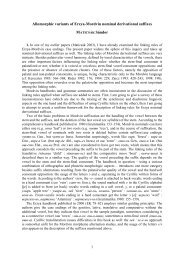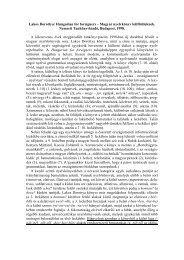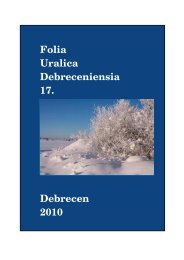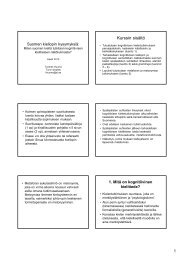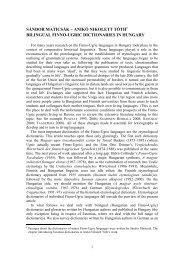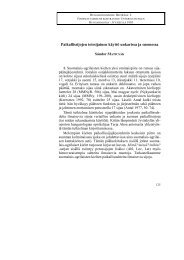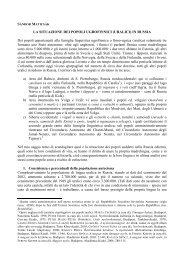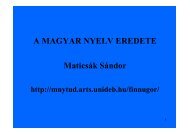folia uralica debreceniensia 19. - Finnugor Nyelvtudományi Tanszék
folia uralica debreceniensia 19. - Finnugor Nyelvtudományi Tanszék
folia uralica debreceniensia 19. - Finnugor Nyelvtudományi Tanszék
Create successful ePaper yourself
Turn your PDF publications into a flip-book with our unique Google optimized e-Paper software.
MORFÉMA-ALTERNÁCIÓK A MOKSA HATÁROZATLAN NÉVRAGOZÁSBAN<br />
Morpheme alternations in the Moksha-Mordvin<br />
indefinite declension II.<br />
With the help of N. V. Butylov, I prepared an outline of the Moksha-<br />
Mordvin indefinite declension in the above paper. I utilized the newer<br />
Moksha (-language) grammar as well (MK 2000), which was a great help in<br />
providing exact information about the present-day orthographical practice. In<br />
the majority of the issues, however, it was M. Ye. Yevsev’ev’s paper (1934/<br />
1963) that served as a basis for clarification. The first part of my study was<br />
published in the previous issue of the journal (FUD 18: 99–116).<br />
Sándor Maticsák differentiates between five distinctive features that determine<br />
the linking rules of the Erzya case endings (Maticsák 2003: 143). I used<br />
his system to describe the relationship between the stem and the case endings<br />
in Moksha. The order of discussion is somewhat modified here, however,<br />
since I applied a different kind of classification for the case endings. On the<br />
other hand, it is obvious that Moksha phonetics differs from Erzya phonetics,<br />
and therefore it was necessary to add some further features to the system. In<br />
addition, I studied the linking rules of the plural nominative in both of the<br />
dialects.<br />
I differentiated between eight distinctive features in Moksha, instead of<br />
the five features applicable in Erzya, but one of these is only relevant in<br />
Erzya, therefore, only seven of the features were needed for the description<br />
of the Erzya morpheme alternations. Items ‘a’, ‘b’ and ‘c’ in the Moksha description<br />
correspond to item ‘a’ in the Erzya description, ‘d’ corresponds to<br />
the Erzya ‘b’, ‘f’ and ‘g’ to the Erzya ‘d’, and ‘g’ to the Erzya ‘e’. The eighth,<br />
‘e’, item of the Moksha description is a feature only relevant in Erzya (item<br />
‘c’ in the Erzya description), and not in Moksha.<br />
The relationship between the stem and the case endings is discussed in the<br />
following order, general suffixes: 1) nominative, 2) genitive(-accusative), dative(-allative),<br />
and locative suffixes: 3) lative, ablative, 4) illative, inessive,<br />
elative (cf. FUD 18: 100–113); 5) prolative, abessive, translative, comparative,<br />
causative, 6) plural nominative.<br />
In summary, we can establish that based on the distinctive features, the<br />
following stem-types (nominative) can be distinguished:<br />
I. Stem-final vowel: 1) full: V[-red] (a, ä, o, e, i), 2) reduced: V[+red] (ä)<br />
II. Stem-final consonant or consonant-cluster: 1) hard [-pal] or soft [+pal],<br />
2) voiceless [-voiced] or voiced [+voiced], 3) obstruent or sonorant, plosive,<br />
fricative, affricate [-son], and liquid or nasal [+son].<br />
123



